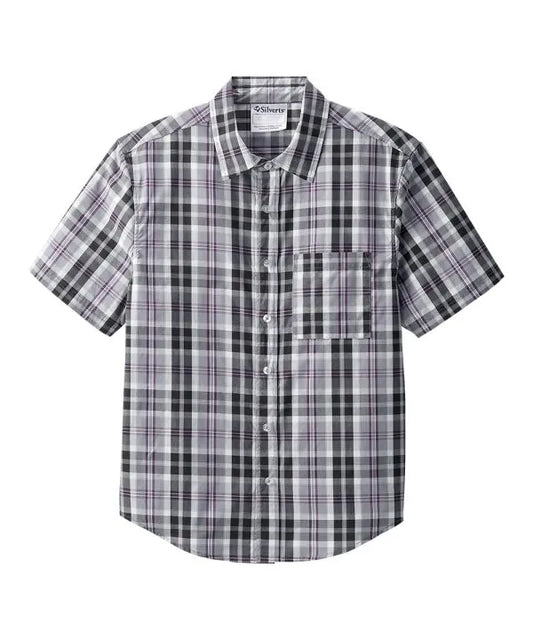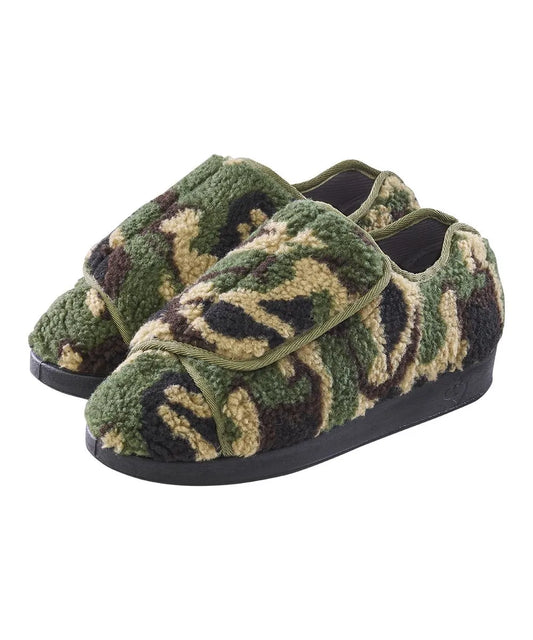Written by Tara Chen & reviewed by Nicole Fernandes.
Everyday tasks, such as dressing, can be difficult for individuals with one functional hand due to injury, paralysis, amputation, or other conditions. It may cause frustration and a feeling of a loss of independence. Luckily, there are dressing techniques and adaptive clothing choices that can help individuals with one hand in their dressing routine. In this article, we will explore the different clothing options and techniques available.
Tops
1. Magnetic closures
Traditional tops such as cardigans or zip-up hoodies have buttons or zippers, which require two hands to fasten. This type of mechanism would be difficult for those with one hand to do and may result in frustration. Fortunately, adaptive clothing incorporates magnetic closure into garments to remove the need for complex closure mechanisms. Magnetic closures are magnets sewn within the fabric of a garment and only require one hand to fasten. Simply bring one side of the garment close to the second side of the garment, and the magnets will attract and snap closed! It is simple, reduces the time needed to get dressed, and makes a secure closure.
For example, June Adaptive offers a Men’s Sherpa Lined Jacket with Magnetic Buttons, available in six sizes and three prints. It is extremely useful for those with limited hand usage, and it also features a soft flannel and comfortable fabric.

2. Front-closure bras
Bras tend to be fastened with several tiny metal hooks at the back, requiring practice, fine motor skills, and complex movements involving two hands. This type of closure tends to be incredibly difficult for individuals with one hand to perform, leading to frustration and a loss of independence. Fortunately, adaptive bras include front-closure bras where there is a clasp or strong magnet in the front, which eliminates the need to extend your arm backwards or perform any complex hand movements. It allows individuals to quickly fasten and unfasten bras with ease with only one hand. They also provide convenience and comfort, ensuring that individuals can easily dress themselves without additional help.
Bottoms
1. Elastic waistbands
Traditional waistbands have zippers and a button, which require two hands to fasten. This type of mechanism would be difficult for those with one hand to do, but adaptive clothing replaces the zipper and button with an elastic waistband to bypass that requirement. An elastic waistband allows for practicality and reduces the time needed to put on pants or skirts. It also simplifies the dressing process, and the individual can easily pull up or pull down the pants. In addition, they are comfortable, flexible, expand to the size of the wearer, and promote independence for the individual with one hand.
For instance, June Adaptive offers Men’s Pull-on Cargo Pants in six sizes and three colours. It includes pull-up loops on the inside, an elastic waistband, and a magnetic fly opening!

2. Adaptive belts
Belts tend to involve complex buckling and maneuvers that require fine motor skills and two hands, which make it difficult for individuals with one hand to perform. However, adaptive belts are an alternative option that has an elastic band or Velcro closure. This removes the need for complex closure mechanisms, and individuals with one hand can tighten their belts easily and more quickly. They are also comfortable to wear, and tight and secure. With adaptive belts, individuals with one hand can maintain their independence and their style, while ensuring practicality.
Footwear
1. Velcro straps
Most shoes feature shoelaces that require tying or metal closures for high heels. These types of closures require two hands and fine motor skills, which make it difficult for those with one hand to perform. Luckily, adaptive footwear incorporates Velcro straps so that shoes can be fastened with just one hand. This eliminates the need for complicated hand movements and reduces the time spent putting on a pair of shoes. Velcro is also secure, easily adjustable, and able to be unfastened with just one hand. This convenience and simplicity allow individuals to confidently manage their dressing needs.
2. Slip-on shoes
An alternative to shoelaces and Velcro straps for shoes are slip-on shoes, which eliminate the need to complex fine motor movements. Slip-on shoes are not only worn by individuals with one hand but also by individuals with two hands. The wearer can simply stretch the opening of the shoe and slide their foot in. These types of shoes also have elastic or stretchy inserts that allow for additional comfort and more ease when dressing. Additionally, slip-on shoes come in various styles, including loafers, sneakers, and flats, providing a wide range of options for different occasions. With slip-on shoes, individuals can confidently and independently put on their footwear, promoting convenience and autonomy in their daily lives.
3. Adaptive socks
Socks are another clothing item that can be modified to help individuals with one hand have more ease when dressing. Adaptive socks may feature open toes, wider openings, or non-slip grips, which make it easier for the individual to take the sock off and put the sock on. Specifically, an open-toe design allows the individual to slip their foot into the sock without having to navigate the toes individually. Also, wider openings in adaptive socks accommodate different foot sizes and reduce the need for precise positioning. It also eliminates the need to use both hands to stretch open the sock. Moreover, non-slip grips on the soles of socks provide stability, balance, and safety by preventing the socks from sliding on smooth surfaces.
Accessories
1. Adaptive gloves
Gloves tend to have a tighter fit for warmth and style, which makes it difficult for individuals with one hand to maneuver and put on. However, adaptive gloves are designed with wider openings, and Velcro or magnetic closures, which make it easier to wear gloves. The wider openings allow for easier insertion of the hand, accommodating limited hand mobility. Velcro or magnetic closures eliminate the need for complex hand movements, enabling individuals to secure the gloves independently. Adaptive gloves provide both protection and warmth while ensuring individuals can effortlessly dress their hands with ease.
2. Magnetic jewelry closures
Jewelry closures typically consist of complex hooks that are difficult to clasp. With magnetic closures, however, bracelets and necklaces can be easily put on and taken off. With a simple touch, the magnets in the jewelry can attract and connect, providing a secure closure that holds the jewelry in place. Additionally, magnetic closures come in a variety of designs, ranging from discreetly hidden magnets to decorative magnetic clasps that enhance the overall aesthetic of the bracelet. Magnetic bracelet closures provide a functional and fashionable option, allowing individuals to enjoy wearing bracelets independently while adding a touch of style to their outfits.
For instance, June Adaptive offers a Turkey Bracelet with Vintage Copper Magnetic Closure. It adds a pop of colour to any outfit and is handmade by artisans in Turkey!

3. Adaptive watch bands
Watch bands tend to have metal closures that involve intricate fine motor movements to fasten, which can be frustrating to perform for those with one hand. However, adaptive watch bands are those with innovative closures that make it easier to put on and remove the watch with one hand. These closures can include magnetic clasps, Velcro, or stretchable bands. Adaptive watch bands offer adjustability and ease of use, allowing individuals to comfortably wear and adjust their watches independently. They can also come in various styles, including leather, metal, or fabric bands, which ensures a wide range of options to suit different preferences and occasions. By choosing adaptive watch bands, individuals can effortlessly keep track of time, while enhancing their personal style.
Dressing Strategies
1. Organizational strategies
Creating an organized closet or drawer system can help individuals with one hand get dressed each morning. Clothes can be categorized based on how easy they are to put on, and garments from adaptive clothing companies can be placed at the front of the closet for easier access. This type of organization can allow individuals with one hand quickly locate and access garments that are more manageable to dress in independently. In addition, clothing items that have more complex closures do not need to be thrown out. They can be reserved for special occasions or for days when the individual can receive assistance from others. Overall, an organized system streamlines the dressing process, promotes independence, and allows individuals to maintain control over their wardrobe choices.
2. Seek help from occupational therapy
Individuals with one hand who want additional guidance and support may receive help from an occupational therapist specializing in assistive techniques for dressing. Occupational therapists may provide personalized assessments and recommendations based on an individual's specific needs and abilities. They can also teach techniques to help overcome dressing challenges, suggest certain adaptive devices, and offer valuable insights on maximizing independence in daily dressing routines. Seeking occupational therapy ensures a comprehensive and individualized approach to optimizing one-handed dressing techniques.
Overall, adapted clothing and dressing strategies for individuals with one hand can greatly enhance their daily living and promote independence. By carefully selecting clothing items, preparing garments in advance, and utilizing adaptive clothing and accessories, individuals with single-handed mobility challenges can confidently dress themselves.
It is important to explore different strategies and adapt clothing choices that cater to individual needs and abilities. With the right tools and techniques, dressing becomes an empowering and manageable task, allowing individuals with one hand to embrace a more adaptive and fulfilling lifestyle.















